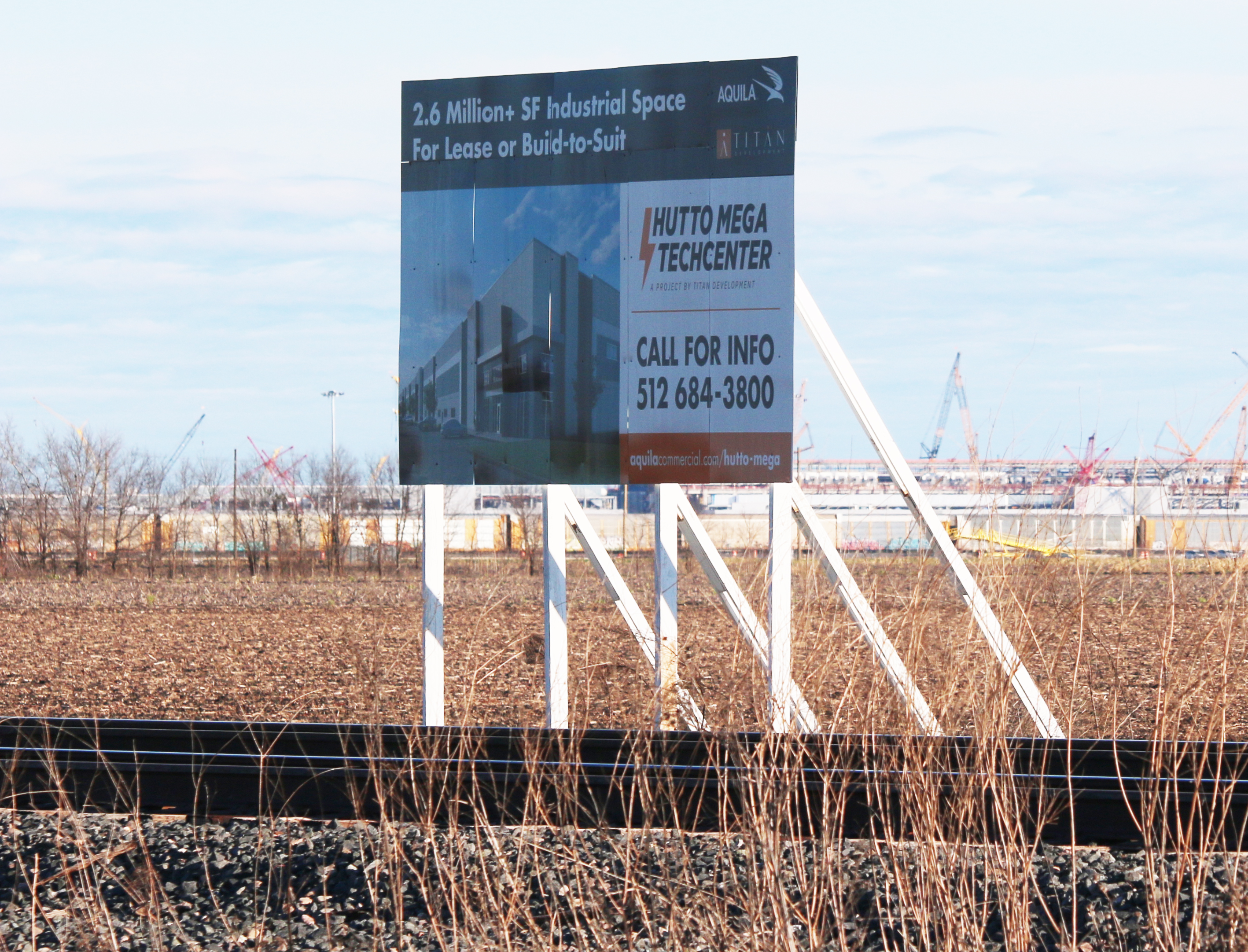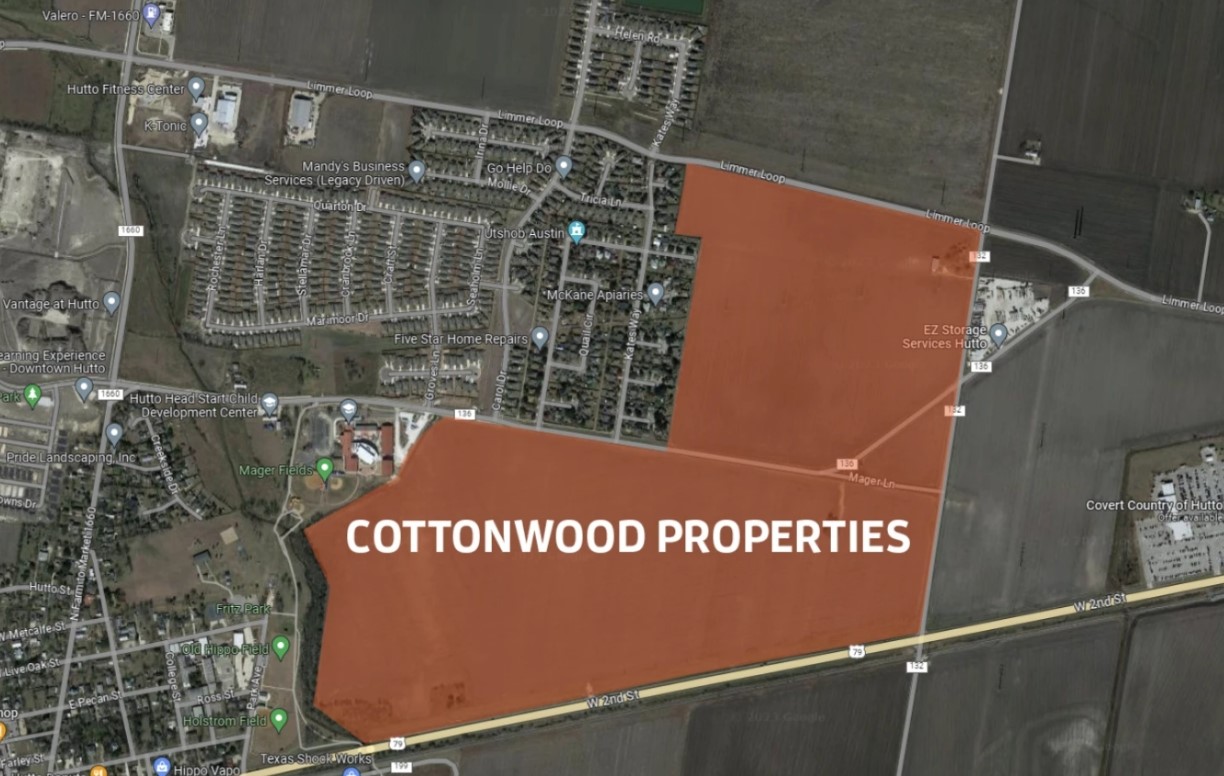HUTTO — The multibillion-dollar Hutto Megasite is shaping up as a high-tech hub to spur regional growth, but it’s not without critics who say the town’s infrastructure should come first.
Over the next 10 years, 1,400 acres of prime land at 12100 U.S. 79 will house a variety of cutting-edge businesses, officials said. Two industrial giants have projects ready to get underway at the site, Titan Development Ltd. and Skybox Datacenters LLC partnering with ProLogis Inc.
Meanwhile, Mayor Mike Snyder and several residents are cautioning that progress shouldn’t come at the price of shortchanging local needs, including improving streets and taking care of potholes.
“I could really go for a break for enough time to get the infrastructure caught up,” Snyder told social-media followers after attending a recent Williamson County Growth Summit where panelists discussed how to lure more industry to the area. “I’m told by several members on (City) Council things like, ‘If we aren’t growing, we’re dying.’” He added, “I keep pushing to do roads and to not go out of the way to bring more development in. Just let it happen.”
Residents have spoken out about poor road conditions throughout the city, a situation that has not been helped by the increased volume of large trucks driving through to construction sites.
Neighbors said traffic congestion has increased dramatically and wastewater processing is a sore point, with the city warning residents of utility-bill increases needed to build a new $198 million wastewater plant.
However, the benefits to the city from enterprises locating at the Megasite will play out in the long run, said Cheney Gamboa, Hutto’s economic development director.
“The intent behind industrial development, especially if it’s done thoughtfully, is to ease the financial burden of a city. Any city that’s growing is going to incur growing pains for infrastructure,” Gamboa said. “That growth is a result of not just industrial development but also the rooftops, and so as long as people are moving to Hutto we’re going to see those challenges.”
HUTTO MEGASITE INDUSTRIES
The industries helping to launch the technology park are just the first of many that will bolster the local economy and call eastern Williamson County home.
PowerCampus Austin by Skybox Datacenters and ProLogis are planned to be six buildings with 3.9 million square feet. The campus will sit on 159 acres along 79 and CR 132. The investment value is estimated to be between $5 billion to $10 billion.
Ground preparation is already being done on the project.

Hutto Mega TechCenter by Titan Development is expected to comprise six buildings suitable for light industry on 188 acres. The buildings will range from 250,000 to 750,000 square feet. Development has not yet begun.
Three more unnamed companies also have plans for the complex, listed by the city as projects.
Project Flex will offer smaller flex office and warehouse buildings. Project Sequel is listed as another data center with possible warehousing and manufacturing space. Project Strat3 will provide supplychain logistics and freight support for semiconductor companies including Samsung Austin Semiconductor, located just four miles away in Taylor.
While the companies behind the projects are still being kept secret, the prospective buyers have signed purchaseand- sale agreements for the land and are in the due-diligence phase before closing, which is expected to happen late in 2024.
A fourth prospect, Project Fe, was announced by Gamboa in December. Project Fe will be a flex-office industrial project adding smaller space options for companies looking to locate in Hutto.
The contract is expected to be presented to City Council for consideration in January.
IMPACT TO TAX BASE
In spite of the critics, Gamboa stressed the importance of growth being meaningful. She said the Hutto Econom ic Development Corp. has been intentional in the projects that it considers for the technology park and other industrial areas of Hutto.
ic Development Corp. has been intentional in the projects that it considers for the technology park and other industrial areas of Hutto.
“The data centers are a kind of unicorn because they have a big impact to the tax base but low infrastructure demand. Air-chilled cooling systems significantly decrease the demand on water and wastewater,” Gamboa said.
She said with low truck traffic and low employment, yet high-value buildings, data centers check all the boxes on the type of development beneficial to the town.
Other experts said development is not completely to blame for Hutto’s infrastructure woes.
“I think the bigger issue is that you have so many entities involved. Williamson County and (the) Texas Department of Transportation also play into the city’s ability to do roads, so it’s a very complicated issue when it comes to transportation over all,” said Mike Fowler, a real estate professional and former Hutto mayor. “It’s not an easy fix and it’s not all just related to growth,” Part of the equation is no growth, no money.
“Sometimes, they’ve had transportation plans on the books for years that they’ve wanted to do, but because the growth isn’t there yet, the money isn’t there either,” he added.
TIRZ APPROVED
Once the developments happen, it will help bring in property-tax revenue that can go toward infrastructure, but the timelines for full activation of large sites can be several years.
EDC officials said it may take a decade to finish development on the Megasite.
The council approved creation of a tax increment-reinvestment zone at the Megasite in 2022.
TIRZs are special zones approved by a city to attract new investment by helping finance costs of redevelopment and promote growth in places that wouldn’t normally attract development. Taxes are set aside in a fund to pay for public improvements in the zone.
City data shows the TIRZ could bring an additional $78 million in new tax revenue by 2047, but incentives and continuing construction means the fund could be slow to build.
Gamboa said she expected the three code-names projects that are already under contract to close on their land sales in late 2024, so groundbreaking for those is potentially a year away.
A key element for progress in the Megasite is the creation of a road to reach the area. The EDC has budgeted $16.7 million for an east-west arterial access point temporarily dubbed the Spine Road, but road construction faced several delays.
.jpg)
According to the city, Titan served the EDC with a notice of default on their previous agreement in April after parameters surrounding the construction of Spine Road were not met.
“Over the last several weeks, the HEDC, Titan and city of Hutto leadership have been working together to draft a new mutually agreed upon agreement,” said city spokeswoman Allison Strupeck in a prepared release.
The new deal will incorporate design changes and added road access. The EDC has named Jordan Foster Construction as the contractor for the road, which is on track to be completed by fall 2024.
The road’s official name should be decided very quickly, according to officials.
RISING TIDE
Meaningful growth does not happen without collaboration between stakeholders, proponents of the Megasite said. Large developments often require greater infrastructure commitments from the city, but can also contribute significantly to the city’s tax base, helping the municipality to offset development costs.
“Megasite land sales help the city pay off other debt like the Cottonwood Properties and the Spine Road,” Gamboa said.
In order to secure Cottonwood Properties, a mixed-use development site, the EDC took out a $25 million loan and received $6 million from the city. The economic development director said those debts are planned to be repaid from EDC’s sales of the Megasite land.
“Typically, industrial is not the most sexy kind of development. The average person is not super excited about a logistics company or (research and development) facility located in their community,” she said. “However the opportunity is two-fold.”
The reasons are many, she said. “One is the opportunity to diversify the tax base. That is hugely impactful for the city and the region,” Gamboa said. On the other hand, we have an opportunity to create a workforce center.”
Gamboa added strategic development was mutually beneficial for not only the company investing in the community, but for the city, the residents and the entire region.
“One of the things that’s really valuable about Williamson County and our strategy is that it’s very collaborative. There’s a partnership, Williamson County Economic Development Partnership, made up of eight cities and we all come together and discuss challenges and opportunities,” Gamboa said.
“I think that speaks volumes about the environment that these companies are going to want to be part of, and we’re going to be proud of this collaboration for a long time,” she added.







Comment
Comments